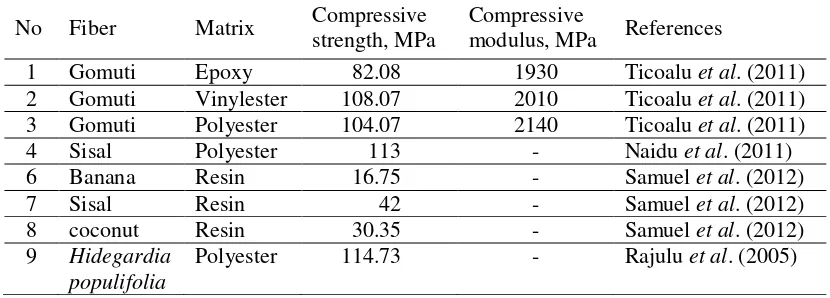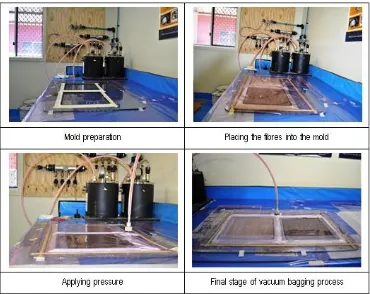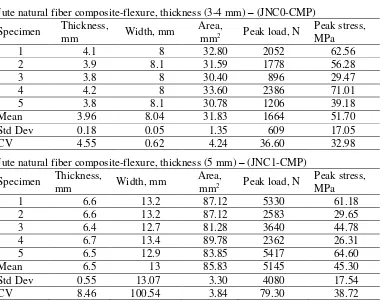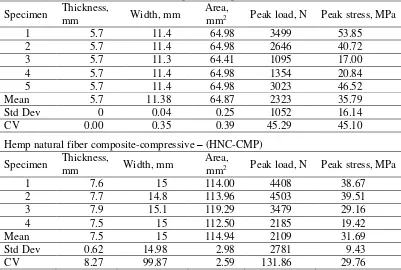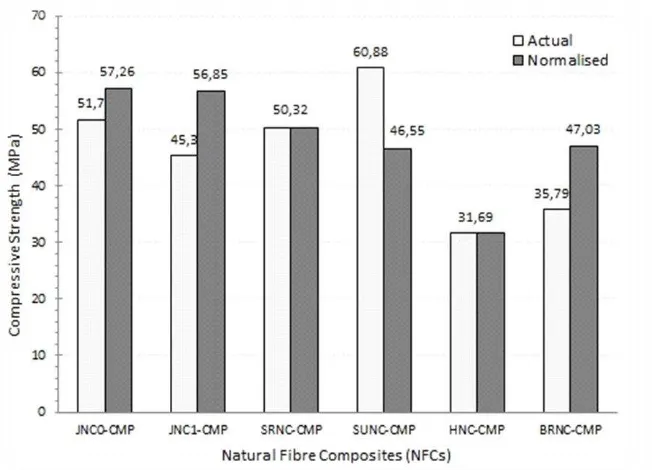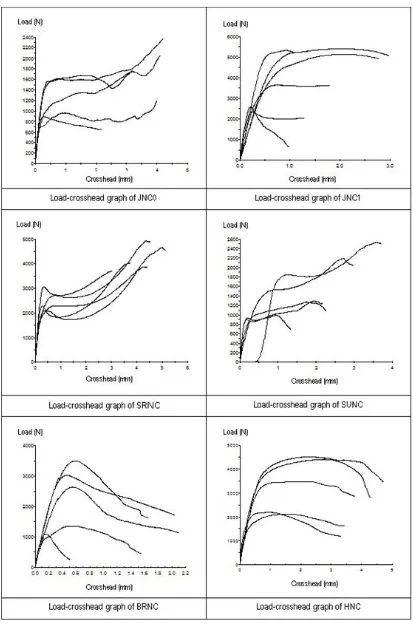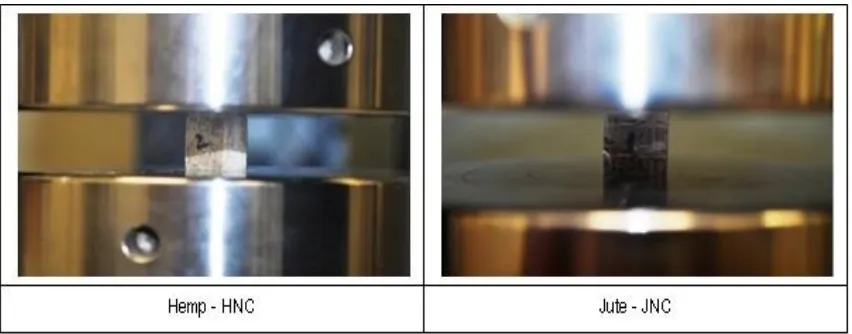Compressive Properties of Tropical Natural Fibers Reinforced
Epoxy Polymer Composites
Jauhar Fajrin*
Department of Civil Engineering, Faculty of Engineering, Universitas Mataram, West Nusa Tenggara, Indonesia, 83115.
*Corresponding author: [email protected]
Abstract
Fiber reinforced plastics composites are particularly valued for their high tensile strength. Other mechanical properties, especially compressive strength is often overlooked during the characterization process. In fact, the comparatively low compression strength of some composite reduces their promising application. This paper presents the experimental investigation on the compressive strength of epoxy polymer composites reinforced by natural fibers of sisal, jute, hemp and bamboo grown in tropical area. The natural fiber composites were prepared using vacuum bagging method and the fibers were treated with alkali treatment prior to further processing. The results showed that the average values of compressive strength obtained in this work ranged from 31.69 MPa to 86.64 MPa. Those results indicate that the obtained compressive strength of natural fibers composites investigated in this research were comparable to the results of previous work, which ranged from from 16.75 MPa to 108.07 MPa.
Keywords: compressive strength, epoxy, natural fiber composites, vacuum bagging
Abstrak
Komposit polimer yang diperkuat dengan serat biasanya dihargai secara khusus berdasarkan kekuatan tarik yang dimilikinya. Sifat mekanik yang lain, khususnya kuat tekan seringkali diabaikan dalam proses karakterisasi. Padahal, kuat tekan yang rendah akan mengurangi peluang aplikasi dari produk komposit meskipun mempunyai kuat tarik yang tinggi. Artikel ini mempresentasikan hasil penelitian eksperimen yang dilakukan dengan menguji kuat tekan komposit resin epoxy polimer yang diperkuat dengan beberapa serat alam yang biasa tumbuh di daerah tropis; sisal, jute, hemp dan bambu. Komposit dibuat dengan metode vacuum bagging dan serat alam yang digunakan sebagai penguat terlebih dahulu diawetkan dengan perlakuan alkali. Hasil pengujian menunjukan bahwa kuat tekan komposit yang dihasilkan berkisar antara 31 MPa sampai 86 MPa. Hasil tersebut mengindikasikan bahwa kuat tekan komposit yang dihasilkan hampir sama dengan hasil-hasil penelitian yang sudah dilakukan sebelumnya, yakni berkisar antara 16 MPa sampai 108 MPa.
Kata kunci: epoksi, komposit serat alam, kuat tekan, metode vacuum bagging
Introduction
Most of research works in the field of natural fiber composites have been focused only on the tensile and flexural properties of natural fiber composites. Only few works have been related to the compressive and shear properties analysis. Rajulu et al. (2005) reported that the compressive strength of Hildegardia populifolie fiber reinforced polyester resin is about
Table 1 Compressive strength and compressive modulus of different natural fiber composites from several literatures
No Fiber Matrix Compressive strength, MPa
Compressive
modulus, MPa References
1 Gomuti Epoxy 82.08 1930 Ticoalu et al. (2011) strength of polyester composite reinforced with banana, sisal and coconut fibers was 16.75 MPa, 42 MPa, and 30.35 MPa, respectively. In addition, Ticoalu et al. (2012) assessed the effect of using different thermoset resins as the matrices of gomuti fiber composite. It was found that the compressive strength of gomuti/epoxy composite was 82.98 MPa, gomuti/vynilester reached 108 MPa, and 104 MPa for gomuti/polyester composite. The above mentioned compressive strength of natural fiber composites are summarized in Table 1. In reality, fiber reinforced polymer composites are particularly valued for their high tensile strength. However, the comparatively low compressive strength of some composite reduces their potential application. Therefore, measuring the compressive strength of natural fiber composites is of particular interest as well as their tensile strength. This research was aimed at investigating the compressive strength of epoxy resin composite reinforced with natural tropical fibers of sisal, hemp, jute and bamboo.
Materials and Methods Sample preparations
Four tropical natural fibers were used in this research, i.e. sisal, jute hemp
and bamboo. Jute and sisal fibers used in this research were chemically treated using alkali treatment. The alkaline treatment was carried out by soaking natural fibers in 2% NaOH. For the post treatment, the treated fibers were washed several times with warm tap water, neutralized with acetic acid and washed with demineralized water. The fibers were then allowed to dry for 3 days at room temperature. The percentage of NaOH used in this research was 2% by weight (2% wt). A modified low viscosity epoxy resin (R180) was used with a hardener (H180) for the matrix of the composite. The natural fiber laminates were prepared using vacuum bagging method, which is a process that combines a manual method using hand-lay-up or spray-up on the open mold to produce a laminated component with a vacuum process after covering the laminates using polymeric sheet (Kaynak & Akgul 2001, Akovali 2001). The process of sample preparation using vacuum bagging process is shown in Figure 1.
Testing set-up
period. The compressive test of NFCs in this research was carried out as per ASTM D 695M standard. This standard is suitable for measuring compressive strength of NFCs as the natural fiber based composites are not very strong. This standard is not suitable for high strength composites due to the low transverse and
interlaminar strength of these materials that may lead the specimens to fail by crushing or longitudinally splitting (Mathews 2000, Hodgkinson 2000). The test was carried out using a MTS machine with a maximum load capacity of 100 kN.
Figure 1 Process of fabricating natural fiber composite laminates with vacuum bagging method in this research.
Five specimens with recommended dimensions were prepared for each panel. The testing speed was 1.3 mm min-1, as recommended by the referred
standard. The testing set up for the compressive test is shown in Figure 2.
Results and Discussions while the compressive properties of sisal natural fibers are shown in Table 3. Table 4 shows the compressive properties of bamboo based composite and hemp natural fiber composite. The data presented in the above tables has been reorganized in the form of dot-plot diagram in order to obtain more comprehensible and immediate information. The dot-plot diagram of compressive strength of NFCs investigated in this research is presented in Figure 3.
When a glance observation is given to the concentration of data in Figure 3, it seems that only two groups of specimens, SRNC-CMP and HNC-CMP, have a consistent compressive strength distribution. The average values of these two specimens group were 50.32 MPa and 31.69 MPa, respectively. The values of remaining four groups need to be normalized in order to obtain more reliable average values. The analysis was focused only on one single parameter, i.e. compressive strength. Sample JNC0-CMP has an average compressive turned to 57.26 MPa. A similar process was applied to the JNC1-CMP samples which have a definite average value of 45.30 MPa. Excluding the data of specimen 2 and specimen 4, results in new average value of 56.85 MPa Table 2 Compressive properties of jute natural fiber composite
Jute natural fiber composite-flexure, thickness (3-4 mm) – (JNC0-CMP) Specimen Thickness,
Table 3 Compressive properties of sisal natural fiber composite
Sisal (randomly oriented) natural fiber composite-compressive – (SRNC-CMP) Specimen Thickness,
Sisal (unidirectional) natural fiber composite-compressive – (SUNC-CMP) Specimen Thickness,
Table 4 Compressive properties of bamboo based and hemp natural fiber composite Bamboo (randomly oriented) based composite-compressive – (BRNC-CMP)
Specimen Thickness,
Figure 3 The dot-plot diagram of the compressive strength of NFCs.
Figure 4 The average compressive strength values of different NFCs. new average value of 56.85 MPa. It can
be noted here that by doing this normalization process, the difference between the two groups can be significantly reduced, from 11.17% when comparing actual average values to 0.71% after normalization.
The SRNC-CMP specimen group shows less variation in their compressive strength data distribution. The data of this sample group ranges from 44.68 MPa to 59.28 MPa with the
Figure 6 Typical compressive failure patterns of different NFCs. group was 35.79 MPa with the standard deviation of 16.14 MPa. However, the compressive strength of BRNC-CMP has the tendency to separate into two levels. When three higher values of the data are considered, the average value increases to 47.03 MPa and only 18.92 MPa when only two lowest data are considered.
Lastly, the average compressive strength value of different natural fiber composites is presented in Figure 4. The average compressive strength of sample groups represented jute fiber composites, JNC0-CMP and JNC1-CMP, were only slightly different of 57.26 MPa and 56.85 MPa. Their values are ranked as the highest among the other NFCs and these values are followed by sisal fiber composites, both SRNC-CMP and SUNC-CMP. The value of these two specimen groups was 50.32 MPa and 46.55 MPa. Nested in the last place is the hemp fiber composite (HNC-CMP) with average value of 31.69 MPa. Bamboo based composite (BRNC-CMP) has an average value higher than HNC-CMP and comparable to the average value of SUNC-CMP, which is 47.03 MPa.
Load-deformation relationship and failure modes
(unidirectional). Hemp fiber composite has the average compressive strength value of 31.69 MPa, while bamboo based composite has the average value of compressive strength of 47.03 MPa. Those results indicate that the compressive strength of natural fiber composites obtained in this work were acceptable and comparable to the result of previous studies.
References
[ASTM] American Standard Testing and Material D 695 M, 2008. Standard test method for compressive properties of rigid plastics, ASTM International, Philadelphia, Pa 19103.
Kaynak C, Akgul T, 2001. Open mould process. In: Akovali G, editors. Handbook of composite fabrication. Ankara: RAPRA technology, LTD. Pp. 57-86.
Matthews FL, 2000. Compression. In: Hodgkinson JM, editor. Mechanical testing of advanced fiber composites. Cambridge: Woodhead Publishing Limited. Pp. 75-99.
Naidu VNP, Reddy GR, Kumar MA, Reddy MM, Khanam PN, Naidu SV. 2011. Compressive & impact properties of sisal/glass fiber reinforced hybrid composites. Int J Fiber Text Res. 1(1):11-14.
Rajulu AV, Rao GB, Devi LG. 2005. Mechanical properties of short, natural fiber Hildegardia populifolia-reinforced styrenated polyester. J Reinf Plast Compos. 24(4): 423-428.
Samuel OD, Agbo S, Adekanye TA. 2012. Assessing mechanical properties of natural fiber reinforced composites for engineering applications. J Miner Mater Charact Eng. 11:780-784.
Ticoalu A, Aravinthan T, Cardona F. 2012. A review on the characteristics of gomuti fiber and its composites with thermoset resins. J Reinf Plast Compos. 32(2):124– 136.
Riwayat naskah:
